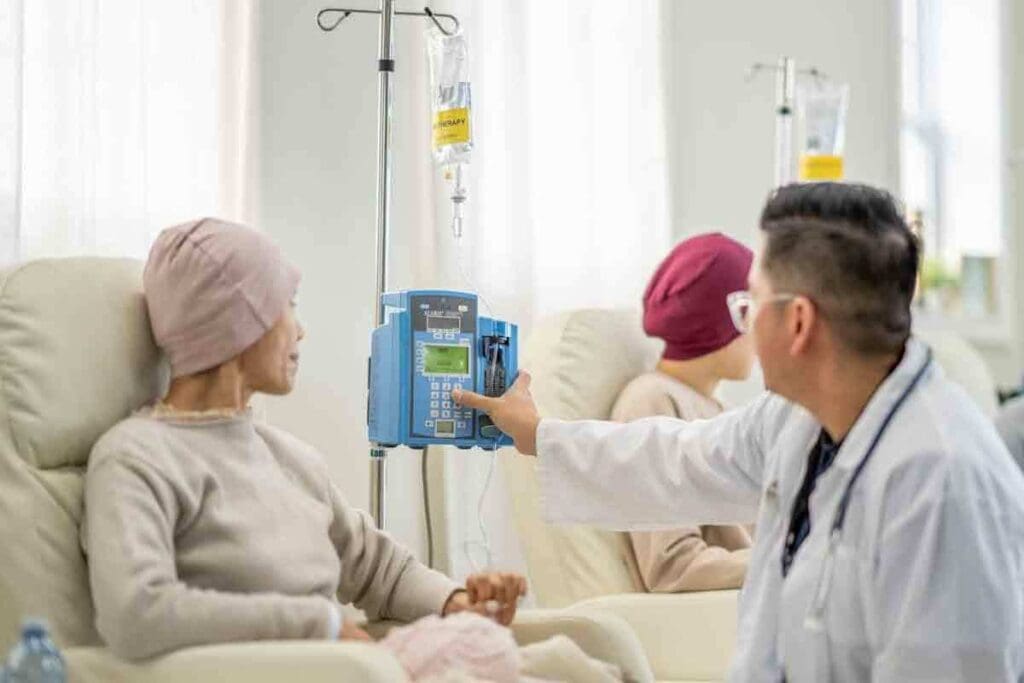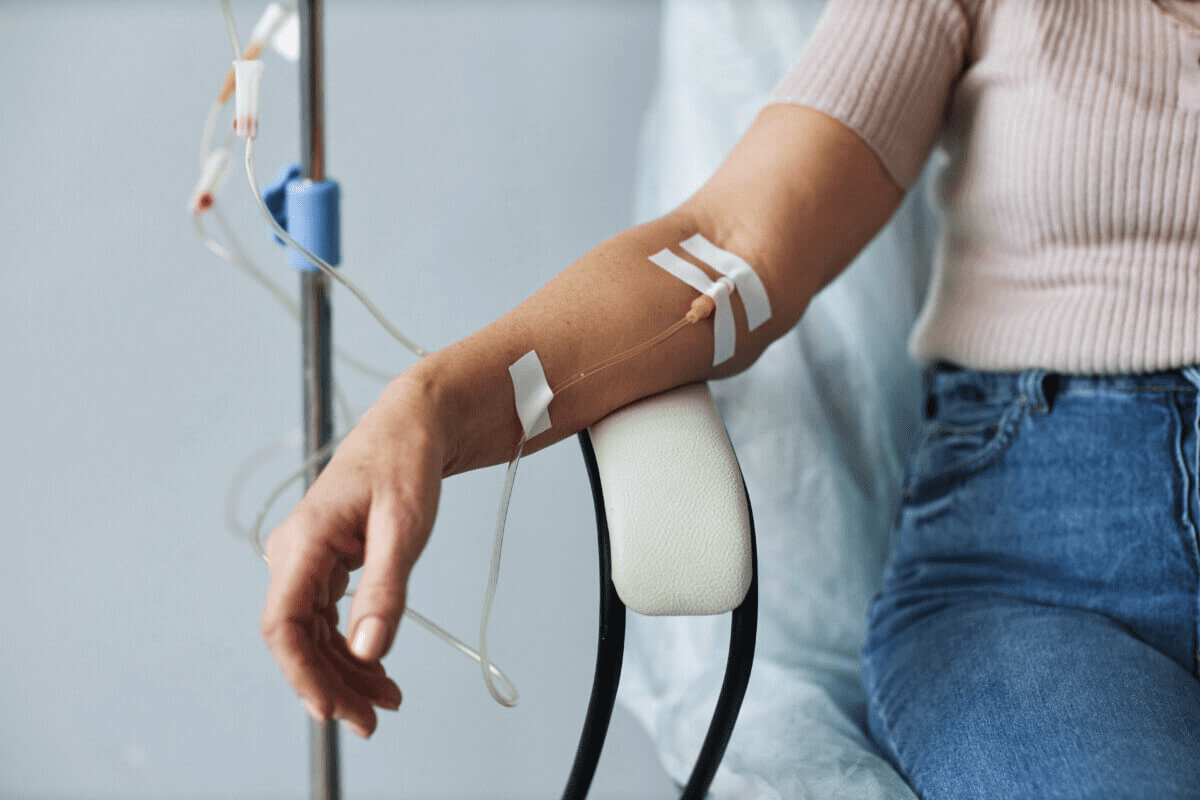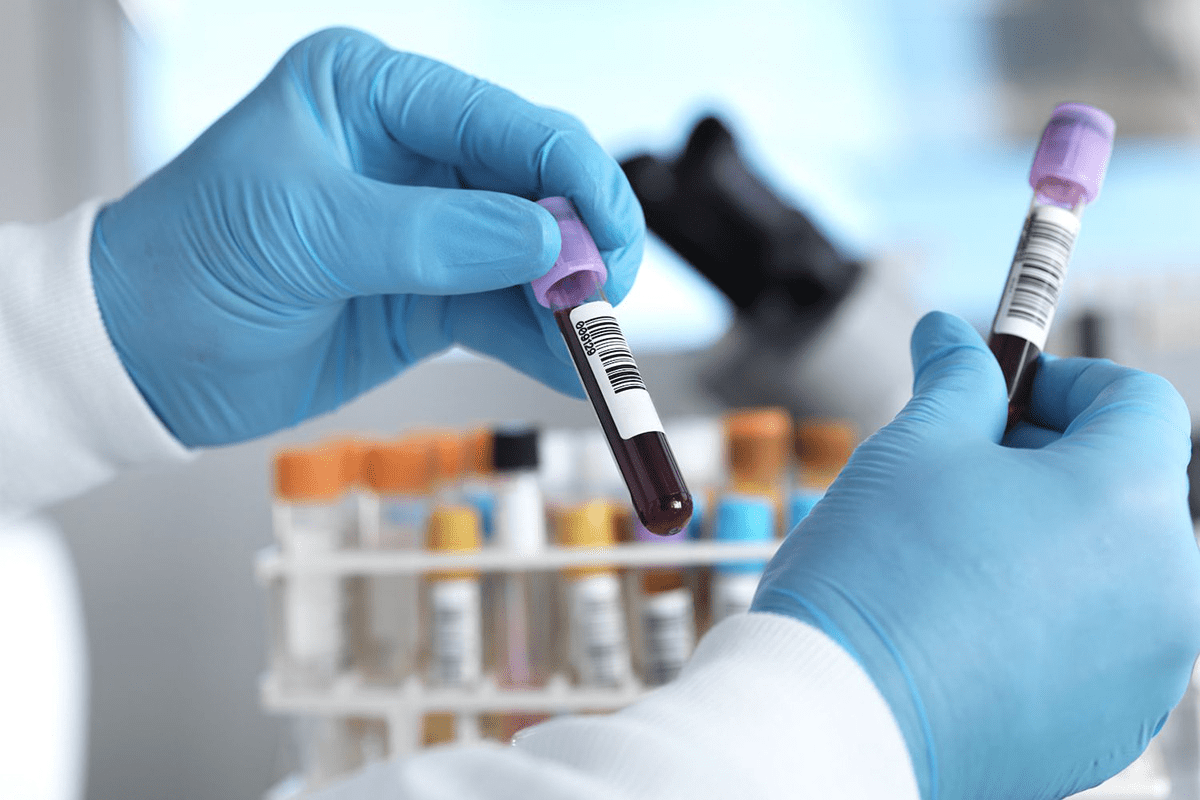Last Updated on November 27, 2025 by Bilal Hasdemir

Radioactive iodine (RAI) treatment is a common way to manage Graves’ disease, a condition that causes too much thyroid hormone in the body. At Liv Hospital, we focus on giving our patients the best care during RAI treatment, including monitoring for possible effects like low TSH after radioactive iodine treatment, which can indicate changes in thyroid function that need attention.
After RAI treatment, many patients see a big change in their thyroid function. This change often leads to hypothyroidism within a year. Research shows that up to 50 percent of patients get hypothyroidism after RAI treatment. This is because of the treatment dose and the size of the thyroid gland.
It’s important to know how RAI treatment affects the thyroid. We will look at 7 key facts about RAI treatment and its effects on Graves’ disease patients.
Key Takeaways
- RAI treatment is a common approach for managing Graves’ disease.
- Hypothyroidism is a frequent outcome after RAI treatment.
- The risk of hypothyroidism is influenced by the dose and thyroid size.
- Comprehensive care is essential for patients undergoing RAI treatment.
- Understanding thyroid function changes is key to effective management.
The Basics of Disease and Thyroid Function
To manage Graves’ disease well, knowing its basics is key. Graves’ disease is an autoimmune disorder that leads to hyperthyroidism. This means the thyroid gland makes too many thyroid hormones. It mostly hits women, and they’re usually between 20 and 50 years old.
Autoimmune Nature of ‘Graves’ Disease
Graves’ disease happens when the immune system attacks the thyroid gland by mistake. This makes the gland make too many thyroid hormones. This attack is caused by antibodies that the body makes.
We don’t know for sure why Graves’ disease happens. But it’s thought that genes and the environment play a part. People with a family history of Graves’ or other autoimmune diseases are more likely to get it.
How TSH Regulates Thyroid Hormones
Thyroid-stimulating hormone (TSH) is key in controlling thyroid hormones. It’s made by the pituitary gland and tells the thyroid gland to make triiodothyronine (T3) and thyroxine (T4). In Graves’ disease, TSH production gets messed up, causing too much thyroid hormone.
| Hormone | Function | Effect in Graves’ Disease |
| TSH | Stimulates thyroid hormone production | Suppressed due to negative feedback |
| T3/T4 | Regulates metabolism, growth, and development | Overproduction, leading to hyperthyroidism |
Symptoms of Untreated Graves’ Disease
If Graves’ disease isn’t treated, it can cause many problems. These include losing weight, feeling your heart beat fast, shaking, and feeling too hot. These happen because there’s too much thyroid hormone in the body.
Spotting these symptoms early is very important. If not treated, Graves’ disease can cause serious issues like heart problems and weak bones.
Radioactive Iodine as a Treatment Option for Graves’ Disease
RAI therapy is a common treatment for Graves’ disease. It uses radioactive iodine to shrink the thyroid gland. This method has been used for many years and is very effective in treating hyperthyroidism.
How RAI Therapy Works
Radioactive iodine therapy destroys part or all of the thyroid gland. This reduces thyroid hormone production. The treatment is taken orally and targets the thyroid gland.
The therapy is safe because it only affects the thyroid gland. The American Thyroid Association says it’s a safe and effective treatment. It often leads to a healthy thyroid hormone level.
“Radioactive iodine is a simple, safe, and effective treatment for hyperthyroidism caused by Graves’ disease.”
American Thyroid Association
Preparation for RAI Treatment
Before RAI therapy, patients should:
- Avoid iodine-rich foods and supplements for a few weeks.
- Tell their doctor about any medications they’re taking.
- Discuss any concerns or questions with their doctor.
It’s important to note that RAI therapy isn’t for everyone. Pregnant or breastfeeding women should not have it because of radiation risks.
What to Expect During the Procedure
The RAI treatment is simple. Patients swallow a capsule or liquid with radioactive iodine. The dose is based on the severity of hyperthyroidism and the size of the thyroid gland.
After swallowing, patients are watched for any immediate side effects. Sometimes, they need to stay in the hospital for a few days. This depends on the dose and local radiation safety rules.
Key benefits of RAI therapy include:
- High success rate in treating hyperthyroidism.
- Minimally invasive procedure.
- Effective in reducing thyroid hormone production.
Understanding RAI therapy, preparing well, and knowing what to expect helps patients make informed choices. This is important for treating Graves’ disease.
Key Fact #1: Low TSH After Radioactive Iodine Treatment is Expected
Low TSH after RAI treatment is common and expected. It shows the treatment’s impact on the thyroid gland. Understanding these changes is key for patients with Graves’ disease.
Understanding Post-Treatment TSH Patterns
RAI treatment affects the thyroid gland’s hormone production. This can cause TSH levels to change. It’s important to watch TSH levels after RAI to see how well the treatment worked.
At first, TSH levels might stay low because of extra thyroid hormones. As hormone production drops, TSH levels can go up and down before settling.
Normal vs. Abnormal TSH Ranges
Knowing the normal TSH range is key to understanding post-RAI levels. A normal range is usually 0.4 to 4.0 mIU/L. Levels outside this range might mean thyroid problems.
| TSH Level (mIU/L) | Interpretation | Post-RAI Implication |
| 0.4 – 4.0 | Normal | Stable thyroid function post-treatment |
| < 0.4 | Low | Possible hyperthyroidism or thyroiditis |
| > 4.0 | High | Possible hypothyroidism, requiring thyroid hormone replacement |
Why TSH Levels Change After RAI
Changes in TSH levels after RAI are mainly due to less thyroid hormone production. RAI destroys thyroid gland parts, reducing hormone production. The pituitary gland then makes more TSH to try to get the thyroid to produce more hormones.
If the thyroid gland is badly damaged, it can’t make enough hormones. This leads to higher TSH levels over time.
It’s important for patients to know that TSH level changes are normal after RAI. Regular check-ups and monitoring are key to managing thyroid health.
Key Fact #2: Hypothyroidism Occurs in Up to 50% of Patients Within 12 Months
RAI treatment can lead to hypothyroidism in many patients. It’s important to know this to manage care after treatment.
Studies show that up to 50% of patients get hypothyroidism within 12 months after RAI treatment. This highlights the need for close thyroid function monitoring after the procedure.
The Transition from Hyperthyroidism to Hypothyroidism
Graves’ disease causes hyperthyroidism, where the thyroid gland makes too much hormone. RAI treatment aims to fix this by destroying part of the gland. But this can sometimes make the gland underactive, leading to hypothyroidism.
The switch from hyperthyroidism to hypothyroidism is a critical time. Patients should watch for symptom changes and tell their doctor. Early detection of hypothyroidism is key to effective management.
Timeline for Developing Hypothyroidism
The time it takes for hypothyroidism to develop after RAI treatment varies. Some may see symptoms in a few months, while others might not for a year or more.
- Within 3-6 months: Some patients may start experiencing hypothyroid symptoms.
- 6-12 months: The risk of developing hypothyroidism peaks during this period.
- Beyond 12 months: Continued monitoring is necessary as some patients may develop hypothyroidism later.
Recognizing Hypothyroid Symptoms
It’s important to know the symptoms of hypothyroidism to get help early. Common signs include fatigue, weight gain, feeling cold, and dry skin. Patients should watch for these changes and talk to their doctor.
Some patients may not notice symptoms at first. Regular check-ups and thyroid tests are key to catching hypothyroidism early.
Key Fact #3: RAI Dosage and Thyroid Size Influence Treatment Outcomes
The success of radioactive iodine (RAI) treatment for Graves’ disease depends on two key factors. These are the RAI dosage and the size of the thyroid gland. Studies have found that adjusting the RAI dose based on the thyroid size can improve treatment results.
Individualized Dosing Strategies
We are moving towards more personalized treatment for Graves’ disease, including RAI dosing. Individualized dosing strategies consider each patient’s thyroid gland size and hyperthyroidism severity. This approach aims to achieve the best results while reducing side effects.
To tailor dosing, doctors use methods like thyroid gland ultrasound. This helps measure the gland’s size and volume. With accurate measurements, they can determine the right RAI dose for each patient.
How Thyroid Volume Affects Response
The size of the thyroid gland is critical in RAI treatment success. Larger glands often need more RAI to achieve the same effect as smaller ones. Understanding this is key to effective treatment planning.
Research shows that patients with larger thyroid glands may respond differently to RAI. This highlights the need to consider thyroid size when planning treatment.
Balancing Efficacy and Side Effects
One challenge in RAI treatment is finding the right balance. A higher dose may be more effective but increases side effect risks, like hypothyroidism. A lower dose may reduce side effects but might not fully treat the condition.
| Thyroid Gland Size | Recommended RAI Dose | Expected Outcome |
| Small ( | Lower dose (e.g., 5-7 mCi) | Effective treatment with a lower risk of hypothyroidism |
| Medium (20-30g) | Standard dose (e.g., 10-12 mCi) | Balanced efficacy and risk of hypothyroidism |
| Large (>30g) | Higher dose (e.g., 15-20 mCi) | Higher efficacy but increased risk of hypothyroidism |
By considering thyroid gland size and tailoring RAI doses, healthcare providers can improve treatment outcomes for Graves’ disease patients.
Key Fact #4: Risk of Persistent Hyperthyroidism After Low-Dose RAI
Studies show that low-dose RAI might not cure hyperthyroidism in all cases. This can cause symptoms to linger, needing more medical help.
Signs of Incomplete Treatment Response
It’s important to know when treatment isn’t working. Look out for symptoms like:
- Rapid heartbeat
- Weight loss
- Heat intolerance
- Nervousness or anxiety
These signs mean the first treatment might not have worked fully.
Follow-up Protocol for Persistent Symptoms
For those with ongoing symptoms, a follow-up plan is key. It usually includes:
- Regular thyroid tests to check TSH and free T4
- Checking how symptoms affect your health
- Changing treatment plans if needed
Your doctor might suggest more tests or different treatments based on how you react to the first RAI therapy.
Options for Secondary Treatment
If low-dose RAI doesn’t work, there are other treatments:
| Treatment Option | Description |
| Higher Dose RAI | A second, higher dose of RAI might be needed to fully treat hyperthyroidism. |
| Antithyroid Medications | Medicines like methimazole can help manage symptoms until a better treatment is found. |
| Surgery | In some cases, removing part or all of the thyroid gland might be an option. |
Choosing further treatment should be based on a full review of your situation and what you prefer.
“The goal of treatment is to achieve a stable euthyroid state, minimizing the risk of long-term complications.”
It’s vital to understand the risks and treatment options for persistent hyperthyroidism after low-dose RAI. Recognizing when treatment isn’t working and following up properly helps healthcare providers offer the right care.
Key Fact #5: RAI Treatment Achieves 90% Remission Rate in Some Patients
RAI treatment is very effective, with a 90% remission rate in some patients. This high success rate makes it a popular choice for treating Graves’ disease.
Success Rates Across Different Demographics
Studies show that RAI treatment success rates differ among various groups. Age, gender, and the severity of hyperthyroidism play a role. For example, younger patients often respond better than older ones.
Demographic factors influencing RAI success rates:
- Age: Younger patients tend to respond better
- Gender: Some studies suggest differences in response between genders
- Severity of hyperthyroidism: More severe cases may require adjusted treatment protocols
Comparing RAI to Antithyroid Drugs and Surgery
RAI is compared to antithyroid drugs and surgery for its effectiveness and safety. Antithyroid drugs offer temporary relief, but RAI provides a more lasting solution by removing the thyroid gland. Surgery, while risky, can also be effective for some.
Key differences between treatment options:
- RAI: Offers high remission rates but may lead to hypothyroidism
- Antithyroid drugs: Provide temporary relief but may have side effects
- Surgery: Carries surgical risks but can be effective for some patients
Predictors of Successful Treatment
Several factors can predict RAI treatment success. These include the thyroid gland size, the RAI dose, and the patient’s initial thyroid hormone levels. Knowing these predictors helps doctors tailor treatment plans for each patient.
Predictors of RAI treatment success:
- Thyroid gland size: Smaller glands may respond better to lower doses
- RAI dosage: Carefully calculated doses improve outcomes
- Initial thyroid hormone levels: Higher levels may require adjusted treatment strategies
Key Fact #6: Long-term Quality of Life Considerations After RAI
Understanding the long-term effects of RAI treatment on quality of life is key for those with Graves’ disease. We will look at life after RAI treatment. This includes physical health, mental adjustments, and how it compares to other treatments.
Physical Health Outcomes 6-10 Years Post-Treatment
Research shows RAI treatment often leads to hypothyroidism. Long-term physical health outcomes are mostly positive. Many patients see improved symptoms and quality of life. Yet, some may face ongoing or new symptoms.
A study in the Journal of Clinical Endocrinology and Metabolism found RAI patients were more likely to have hypothyroidism. Yet, they were generally satisfied with their treatment. These findings are important for understanding RAI’s long-term effects.
Psychological and Emotional Adjustments
Psychological and emotional adjustments after RAI treatment are vital. Patients might feel anxious or depressed. Support from healthcare providers and loved ones is key in helping them cope.
Studies show patients with full care, including mental support, do better long-term. We stress the need for a holistic care approach. This addresses both physical and emotional needs.
Comparison with Other Treatment Approaches
Comparing RAI treatment to other methods like medications or surgery is complex. The right treatment depends on the patient’s needs, disease severity, and personal choices.
| Treatment Approach | Short-term Outcomes | Long-term Outcomes |
| RAI Treatment | Effective in reducing thyroid hormone production | Often results in hypothyroidism, requiring lifelong hormone replacement |
| Antithyroid Medications | Can control symptoms, but may have side effects | May require long-term medication use, with variable success rates |
| Surgery | Can provide definitive treatment, but carries surgical risks | May result in hypothyroidism, with other complications possible |
By looking at these treatments, we can understand their pros and cons. This helps guide patients to the best option for them.
Key Fact #7: Lifelong Hormone Monitoring is Essential
For those who have had RAI treatment, lifelong hormone monitoring is key. It helps manage long-term effects. After radioactive iodine treatment, the thyroid gland can’t make hormones as it should. Regular checks keep hormone levels healthy.
Recommended Testing Schedule
Guidelines suggest regular thyroid hormone level tests after RAI treatment. This includes:
- Initial testing at 4-6 weeks post-treatment
- Follow-up tests every 4-6 weeks until stable hormone levels are achieved
- Ongoing monitoring every 6-12 months
For more detailed information on managing hypothyroidism, a condition often resulting from RAI treatment, you can visit this resource.
Managing Thyroid Hormone Replacement
Thyroid hormone replacement therapy is often needed after RAI treatment. It involves taking synthetic hormones to replace what the thyroid gland can’t make. Effective management of thyroid hormone replacement therapy requires regular monitoring and adjustments to keep hormone levels stable.
When to Adjust Medication Dosages
Over time, thyroid hormone replacement medication dosages may need to be adjusted. Symptoms like fatigue, weight changes, or mood swings can signal the need for a change. Regular check-ups with a healthcare provider are essential to determine the appropriate dosage and make any necessary adjustments.
Key factors that may require medication dosage adjustments include:
- Changes in weight
- Other medications that may interact with thyroid hormone replacement therapy
- Presence of other health conditions
By understanding the importance of lifelong hormone monitoring and working closely with healthcare providers, patients can effectively manage their thyroid health after RAI treatment.
Managing Life After RAI: Practical Guidance for Patients
The journey doesn’t end with Radioactive Iodine treatment; it’s just the start. After treatment, patients must adjust to a new health status. Several key factors help ensure a smooth transition and optimal health outcomes.
Nutrition and Lifestyle Considerations
A well-balanced diet is key after RAI treatment. Nutritional adjustments can help manage hypothyroidism, a common outcome. Patients should eat iodine-rich foods in moderation and get enough selenium, zinc, and other nutrients.
Regular physical activity is also important. It helps manage weight and improve well-being. Stress management through meditation or yoga is also advised.
Communicating with Healthcare Providers
Effective communication with healthcare providers is vital after RAI. Patients should discuss symptoms, any changes, and concerns about their treatment. Keeping a health journal helps track progress and identify patterns.
Understanding your medication regimen, including thyroid hormone replacement therapy, is key. Ask questions if unsure about any part of your treatment.
Support Resources for Disease Patients
Living with Graves’ disease can be tough, but patients don’t have to face it alone. Support groups, online and in-person, offer a community. Educational resources from reputable organizations also provide valuable information.
By focusing on nutrition, lifestyle, communication with healthcare providers, and support resources, patients can manage life after RAI. This improves their overall quality of life.
Conclusion: Navigating Your Graves Disease Treatment Journey
Dealing with Graves’ disease treatment can be tough, but knowing your choices is vital. We’ve looked at how radioactive iodine (RAI) therapy works, its impact on your thyroid, and why watching your health long-term is key.
Research shows RAI is a top choice for treating Graves’ disease, helping most people get better. But it’s important to know it might lead to needing thyroid hormones for life. This knowledge helps patients make smart decisions about their treatment journey.
It’s also critical to get educated and supported during treatment. Working with your healthcare team and staying informed can help you manage your condition well. As you explore your Graves’ disease treatment options, remember to ask for help from doctors and support groups. This way, you can get the best care possible.
FAQ
What is Graves’ disease, a nd how does it affect thyroid function?
Graves’ disease is an autoimmune disorder that causes the thyroid gland to make too many hormones. This leads to symptoms like weight loss, anxiety, and feeling too hot.
How does radioactive iodine (RAI) treatment work for Graves’ disease?
RAI treatment involves taking radioactive iodine that the thyroid gland absorbs. This radiation kills part or all of the thyroid tissue. It helps manage Graves’ disease by reducing hormone production.
What are the expected changes in TSH levels after RAI treatment?
Right after RAI treatment, TSH levels might be low because of too many thyroid hormones. As the gland’s function goes down, TSH levels can go up. Some patients might need thyroid hormone replacement to get TSH levels back to normal.
Why do patients often develop hypothyroidism after RAI treatment?
RAI treatment can damage the thyroid gland, leading to less hormone production. This often results in hypothyroidism, a condition where the gland doesn’t make enough hormones. Patients with hypothyroidism need to take thyroid hormone replacement therapy for life.
How does RAI dosage and thyroid size affect treatment outcomes?
The dose of RAI and the size of the thyroid gland can change how well treatment works. Larger glands or higher doses might need more treatment. Doctors use different doses to find the right balance between effectiveness and side effects.
What are the signs of persistent hyperthyroidism after RAI treatment?
Signs of hyperthyroidism that don’t go away after RAI treatment include weight loss, fast heart rate, or anxiety. Patients with these symptoms need more tests to see if they need more treatment, like another RAI dose or other therapies.
How effective is RAI treatment in achieving remission for Graves’ disease?
RAI treatment can lead to remission in many cases, with success rates up to 90% in some groups. How well RAI works depends on the gland size, the dose, and the patient’s health.
What are the long-term quality of life considerations after RAI treatment?
After RAI treatment, patients might face hypothyroidism, needing thyroid hormone replacement for life. They also need to adjust emotionally and psychologically to manage their condition and find a new normal.
Why is lifelong hormone monitoring necessary after RAI treatment?
Monitoring thyroid hormone levels for life after RAI treatment is key. Regular tests and adjustments to hormone replacement help keep thyroid function right and avoid problems.
What lifestyle changes can help manage life after RAI treatment?
To manage life after RAI treatment, patients should eat well, drink plenty of water, and take care of their health. Talking to doctors and using support groups can also help patients adjust and make necessary changes.
What is the recommended testing schedule after RAI treatment?
After RAI treatment, regular thyroid function tests are needed. These tests check TSH and free thyroid hormone levels to see if hormone replacement needs to be adjusted.
How is thyroid hormone replacement therapy managed after RAI treatment?
Managing thyroid hormone replacement therapy involves changing medication doses based on test results. The goal is to keep hormone levels normal, easing symptoms and preventing long-term issues.
Reference:
National Center for Biotechnology Information – Radioiodine I-131 For The Therapy Of Graves’ Disease






